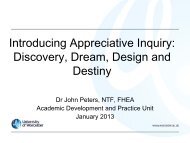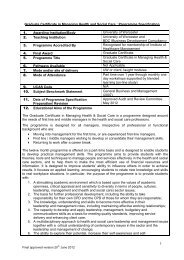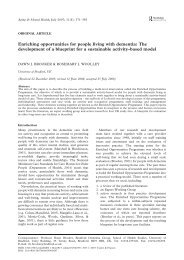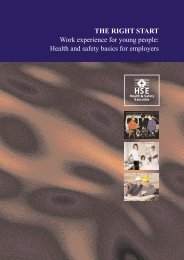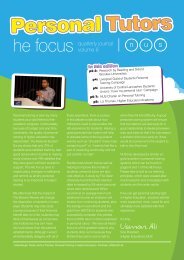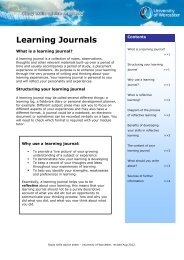Including children with cerebral palsy in mainstream physical
Including children with cerebral palsy in mainstream physical
Including children with cerebral palsy in mainstream physical
You also want an ePaper? Increase the reach of your titles
YUMPU automatically turns print PDFs into web optimized ePapers that Google loves.
Hilderley & Rh<strong>in</strong>d<br />
<strong>Includ<strong>in</strong>g</strong> <strong>children</strong> <strong>with</strong> cp <strong>in</strong> <strong>physical</strong> education<br />
(SEN), have a fundamental right to access PE (Vickerman, Hayes & Whetherly,<br />
2003). To facilitate this, plans have been proposed to promote <strong>in</strong>clusion<br />
(Qualifications and Curriculum Authority, 2007). Indeed, <strong>in</strong>clud<strong>in</strong>g <strong>children</strong> <strong>with</strong><br />
disabilities <strong>in</strong> ma<strong>in</strong>stream PE has become more common <strong>in</strong> recent years (Nadeau &<br />
Tessier, 2006). Based on a review of the literature, Vogler, Koranda and Romance<br />
(2000) proposed that: “<strong>in</strong> <strong>physical</strong> education, <strong>in</strong>clusion has been effective <strong>in</strong><br />
facilitat<strong>in</strong>g motor engagement, motor performance, and the self-concept of <strong>children</strong>”<br />
(p. 162). Further research has suggested that <strong>children</strong> <strong>with</strong> disabilities prefer to<br />
participate <strong>in</strong> the ma<strong>in</strong>stream sport programme (Goodw<strong>in</strong> & Watk<strong>in</strong>son, 2000). Key<br />
questions rema<strong>in</strong>, however, around entitlement, accessibility, <strong>in</strong>tegration and<br />
<strong>in</strong>tegrity (Vickerman et al., 2003). Further research is also required <strong>in</strong> relation to<br />
specific disabilities, such as CP.<br />
Cerebral <strong>palsy</strong> is the most common motor disability <strong>in</strong> young people, “it comprises of<br />
a group of conditions, heterogeneous <strong>in</strong> causation and manifestations, grouped<br />
together ma<strong>in</strong>ly for purposes such as the plann<strong>in</strong>g of habilitation and support”<br />
(Himmelmann et al., 2005, p. 287). Key risk factors for the development of the<br />
condition are “low birth weight, <strong>in</strong>trauter<strong>in</strong>e <strong>in</strong>fections and multiple gestation”<br />
(Odd<strong>in</strong>g, Rowbroeck, & Stam, 2006). Griffiths and Clegg (1988) def<strong>in</strong>ed <strong>cerebral</strong><br />
<strong>palsy</strong> as: “a persistent but not unchang<strong>in</strong>g disorder of posture and movement,<br />
caused by damage to the develop<strong>in</strong>g nervous system, before or dur<strong>in</strong>g birth or <strong>in</strong> the<br />
early months of <strong>in</strong>fancy” (p. 11). Stokes (2004) stated that the different classifications<br />
of CP are based on two th<strong>in</strong>gs: the impairment and the distribution of this<br />
impairment.<br />
The impairment can be spastic, dysk<strong>in</strong>etic, or ataxic. Spastic CP is caused by<br />
damage to the cortex, the child will be stiff <strong>in</strong> one or more limbs and may have<br />
<strong>in</strong>voluntary movements. Dysk<strong>in</strong>etic or athetoid CP is caused by damage to the basal<br />
ganglia or cerebellum, the ma<strong>in</strong> symptom is low muscle tone result<strong>in</strong>g <strong>in</strong> one or more<br />
floppy limbs. Lastly, ataxic <strong>cerebral</strong> <strong>palsy</strong> is caused by damage to the cerebellum<br />
and results <strong>in</strong> shak<strong>in</strong>ess and random movements (Stanton, 1992). The distribution<br />
can be hemiplegia, diplegia or quadriplegia. Hemiplegia means one side of the body<br />
is <strong>in</strong>volved, diplegia means the lower half of the body is <strong>in</strong>volved, and quadriplegia<br />
means that the whole body is affected.<br />
Regardless of the classifications, all CP sufferers will have a degree of decreased<br />
mobility. Children <strong>with</strong> CP are significantly weaker than their able bodied<br />
counterparts (Murphy & Carbone, 2008). In addition, they often have deformities at<br />
the jo<strong>in</strong>ts. Stanton (1992) stated scoliosis (distortion of the sp<strong>in</strong>e) is the most<br />
common deformity <strong>in</strong> <strong>children</strong> <strong>with</strong> CP, followed by hip deformities. PE represents a<br />
potential mechanism through which some of these challenges can be addressed.<br />
Potential Benefits of PE<br />
Bailey (2006) identified a range of possible benefits which can be associated <strong>with</strong><br />
PE. It “…helps <strong>children</strong> to develop respect for the body - their own and others’,<br />
contributes toward the <strong>in</strong>tegrated development of m<strong>in</strong>d and body and develops an<br />
understand<strong>in</strong>g of the role of aerobic and anaerobic <strong>physical</strong> activity <strong>in</strong> health” (p.<br />
397). Further, psychological benefits such as the development of self-esteem and<br />
self-confidence have been highlighted along <strong>with</strong> social benefits such as learn<strong>in</strong>g<br />
important social skills and hav<strong>in</strong>g opportunities to communicate <strong>with</strong> others (Bailey,<br />
© 2012 GJSEPER 2



